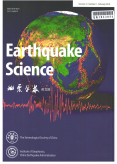- 钛学术文献服务平台 \
- 学术期刊 \
- 基础科学期刊 \
- 天文学、地球科学期刊 \
- 地震学报(英文版)期刊 \
null
A brief discussion on the relationship between apparent stress and slip-weakening law based on the energy partition criteria
基本信息来源于合作网站,原文需代理用户跳转至来源网站获取
摘要:
According to the representation theorem of seismic energy radiation, we know that, at any point on the fault, the instantaneous seismic radiation energy, Es, the seismic moment M0, and the apparent stress σa=μS/Mo(μis the shear modulus on the fault plane) should be positive values at any time during an earthquake faulting. However, we have noticed that, in recent source parameter inversion scheme for deriving the critical slip-weakening distance, the apparent stress used as a constraint condition on the fault plane could be less than zero or negative value, and the negative part was considered as dissipation energy and incorporated to the fracture energy. Although the mathematical formula in such case has no influence to the fmal resolution, however, the earthquake dynamic source process violates obviously the basic physical law, which could results in the overestimating of radiated seismic energy. In this study, we have proposed an alternative way to take ac-count of the apparent stress expression based on the earthquake energy partition principle, and at the same time, we have also suggested that an additional constraint regarding to the radiation energy conservation on the fault could be added into the source parameter inversion in order to estimate the critical slip-weakening distance Dc.

推荐文章
期刊_丙丁烷TDLAS测量系统的吸收峰自动检测
带间级联激光器
调谐半导体激光吸收光谱
雾剂检漏 中红外吸收峰 洛伦兹光谱线型
不同盐度、温度及光照对漂浮浒苔生理生态的影响
浒苔
盐度
温度
光照
生理生态
期刊_联合空间信息的改进低秩稀疏矩阵分解的高光谱异常目标检测
高光谱图像
异常目标检测 低秩稀疏矩阵分解 稀疏矩阵 残差矩阵
内容分析
关键词云
关键词热度
相关文献总数
(/次)
(/年)
引文网络
引文网络
二级参考文献 (0)
共引文献 (0)
参考文献 (6)
节点文献
引证文献 (0)
同被引文献 (0)
二级引证文献 (0)
1968(1)
- 参考文献(1)
- 二级参考文献(0)
1977(2)
- 参考文献(2)
- 二级参考文献(0)
1981(1)
- 参考文献(1)
- 二级参考文献(0)
2000(1)
- 参考文献(1)
- 二级参考文献(0)
2005(1)
- 参考文献(1)
- 二级参考文献(0)
2009(0)
- 参考文献(0)
- 二级参考文献(0)
- 引证文献(0)
- 二级引证文献(0)
引文网络交叉学科
相关学者/机构
期刊影响力
地震学报(英文版)
主办单位:
中国地震学会
出版周期:
双月刊
ISSN:
1674-4519
CN:
11-5695/P
开本:
16开
出版地:
北京民族学院南路5号(北京8116信箱)
邮发代号:
创刊时间:
1980
语种:
eng
出版文献量(篇)
1366
总下载数(次)
0
总被引数(次)
3070
期刊文献
相关文献
推荐文献
- 期刊分类
- 期刊(年)
- 期刊(期)
- 期刊推荐
力学
化学
地球物理学
地质学
基础科学综合
大学学报
天文学
天文学、地球科学
数学
气象学
海洋学
物理学
生物学
生物科学
自然地理学和测绘学
自然科学总论
自然科学理论与方法
资源科学
非线性科学与系统科学
地震学报(英文版)2022
地震学报(英文版)2021
地震学报(英文版)2020
地震学报(英文版)2019
地震学报(英文版)2018
地震学报(英文版)2017
地震学报(英文版)2016
地震学报(英文版)2015
地震学报(英文版)2014
地震学报(英文版)2013
地震学报(英文版)2012
地震学报(英文版)2011
地震学报(英文版)2010
地震学报(英文版)2009
地震学报(英文版)2008
地震学报(英文版)2007
地震学报(英文版)2006
地震学报(英文版)2005
地震学报(英文版)2004
地震学报(英文版)2003
地震学报(英文版)2002
地震学报(英文版)2001
地震学报(英文版)2000
地震学报(英文版)1999
地震学报(英文版)2009年第6期
地震学报(英文版)2009年第5期
地震学报(英文版)2009年第4期
地震学报(英文版)2009年第3期
地震学报(英文版)2009年第2期
地震学报(英文版)2009年第1期

 免费查重
免费查重










